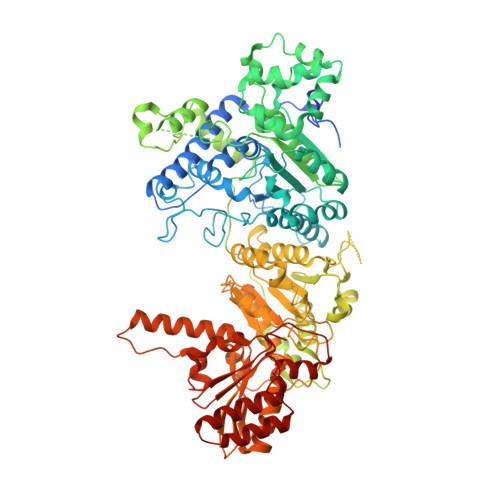Communication between thiamin cofactors in the Escherichia coli pyruvate dehydrogenase complex E1 component active centers: evidence for a "direct pathway" between the 4'-aminopyrimidine N1' atoms.
Nemeria, N.S., Arjunan, P., Chandrasekhar, K., Mossad, M., Tittmann, K., Furey, W., Jordan, F.(2010) J Biol Chem 285: 11197-11209
- PubMed: 20106967
- DOI: https://doi.org/10.1074/jbc.M109.069179
- Primary Citation of Related Structures:
3LPL, 3LQ2, 3LQ4 - PubMed Abstract:
Kinetic, spectroscopic, and structural analysis tested the hypothesis that a chain of residues connecting the 4'-aminopyrimidine N1' atoms of thiamin diphosphates (ThDPs) in the two active centers of the Escherichia coli pyruvate dehydrogenase complex E1 component provides a signal transduction pathway. Substitution of the three acidic residues (Glu(571), Glu(235), and Glu(237)) and Arg(606) resulted in impaired binding of the second ThDP, once the first active center was filled, suggesting a pathway for communication between the two ThDPs. 1) Steady-state kinetic and fluorescence quenching studies revealed that upon E571A, E235A, E237A, and R606A substitutions, ThDP binding in the second active center was affected. 2) Analysis of the kinetics of thiazolium C2 hydrogen/deuterium exchange of enzyme-bound ThDP suggests half-of-the-sites reactivity for the E1 component, with fast (activated site) and slow exchanging sites (dormant site). The E235A and E571A variants gave no evidence for the slow exchanging site, indicating that only one of two active sites is filled with ThDP. 3) Titration of the E235A and E237A variants with methyl acetylphosphonate monitored by circular dichroism suggested that only half of the active sites were filled with a covalent predecarboxylation intermediate analog. 4) Crystal structures of E235A and E571A in complex with ThDP revealed the structural basis for the spectroscopic and kinetic observations and showed that either substitution affects cofactor binding, despite the fact that Glu(235) makes no direct contact with the cofactor. The role of the conserved Glu(571) residue in both catalysis and cofactor orientation is revealed by the combined results for the first time.
Organizational Affiliation:
Department of Chemistry, Rutgers University, Newark, New Jersey 07102, USA.


















